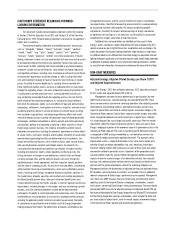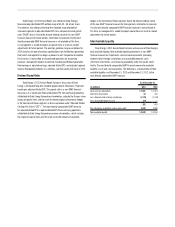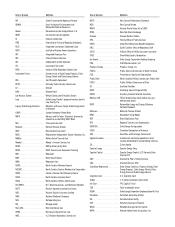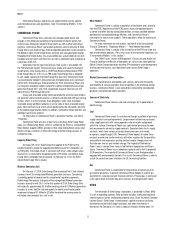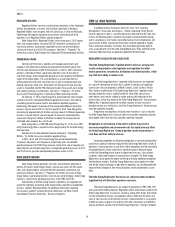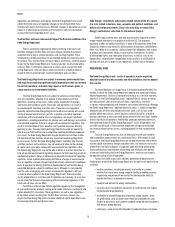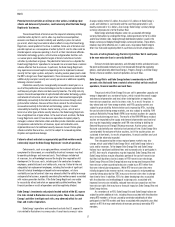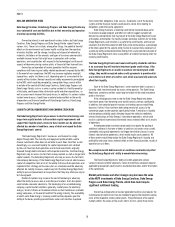Duke Energy 2013 Annual Report Download - page 26
Download and view the complete annual report
Please find page 26 of the 2013 Duke Energy annual report below. You can navigate through the pages in the report by either clicking on the pages listed below, or by using the keyword search tool below to find specific information within the annual report.
PART I
8
that can operate with both fuel oil and natural gas. The cost of Regulated
Utilities’ oil and natural gas is either at a fixed price or determined by market
prices as reported in certain industry publications. Regulated Utilities believes it
has access to an adequate supply of oil and gas for the reasonably foreseeable
future. Regulated Utilities’ natural gas transportation for its gas generation
is purchased under term firm transportation contracts with interstate and
intrastate pipelines. Regulated Utilities may also purchase additional shorter-
term transportation for its load requirements during peak periods. The Regulated
Utilities natural gas plants are served by several supply zones and multiple
pipelines.
Purchased Power
Regulated Utilities purchased approximately 11.7 million megawatt-
hours (MWh), 19.8 million MWh and 19.0 million MWh of its system energy
requirements during 2013, 2012, and 2011, respectively, under purchase
obligations and leases and had 3,800 and 4,500 MW of firm purchased capacity
under contract during 2013 and 2012, respectively. These amounts include MWh
for Duke Energy Progress and Duke Energy Florida for all periods presented.
These agreements include approximately 398 MW of firm capacity under contract
by Duke Energy Florida with certain QFs. Regulated Utilities may need to acquire
additional purchased power capacity in the future to accommodate a portion of
its system load needs. Regulated Utilities believes that it can obtain adequate
purchased power to meet these needs. However, during periods of high demand,
the price and availability of purchased power may be significantly affected.
Gas for Retail Distribution
Regulated Utilities is responsible for the purchase and the subsequent
delivery of natural gas to retail customers in its Ohio and Kentucky service
territories. Regulated Utilities’ natural gas procurement strategy is to buy firm
natural gas supplies and firm interstate pipeline transportation capacity during
the winter season and during the non-heating season through a combination of
firm supply and transportation capacity along with spot supply and interruptible
transportation capacity. This strategy allows Regulated Utilities to assure
reliable natural gas supply for its non-curtailable customers during peak winter
conditions and provides Regulated Utilities the flexibility to reduce its contract
commitments if firm customers choose alternate gas. In 2013, firm supply
purchase commitment agreements provided approximately 100 percent of the
natural gas supply.
Inventory
Generation of electricity is capital intensive. Regulated Utilities must
maintain an adequate stock of fuel and materials and supplies in order to ensure
continuous operation of generating facilities and reliable delivery to customers.
As of December 31, 2013, the inventory balance for Regulated Utilities was
$3,043 million. See Note 1 to the Consolidated Financial Statements, “Summary
of Significant Accounting Policies,” for additional information.
Dan River Ash Basin Release
On February 2, 2014, a break in a stormwater pipe beneath an ash basin
at Duke Energy Carolinas’ retired Dan River steam station caused a release of
ash basin water and ash into the Dan River. On February 8, 2014, a permanent
plug was installed in the stormwater pipe stopping the release of materials into
the river. Duke Energy Carolinas estimates 30,000 to 39,000 tons of ash and
24 million to 27 million gallons of basin water were released into the river.
Duke Energy cannot reasonably estimate the cost associated with
remediation of this release at this time. Other costs related to the Dan River
release and other ash basins, including regulatory directives, natural resources
damages, future lawsuits, future claims, long-term environmental impact
costs, long-term operational changes, and costs associated with new laws and
regulations cannot be reasonably estimated at this time.
Nuclear Matters
Regulated Utilities owns, wholly or partially, 12 nuclear reactors located at
seven stations. Nuclear insurance includes: nuclear liability coverage; property,
decontamination and premature decommissioning coverage; and replacement
power expense coverage. Joint owners reimburse Regulated Utilities for certain
expenses associated with nuclear insurance in accordance with joint owner
agreements. The Price-Anderson Act requires plant owners to provide for public
nuclear liability claims resulting from nuclear incidents to the maximum total
financial protection liability, which currently is $13.6 billion. See Note 5 to the
Consolidated Financial Statements, “Commitments and Contingencies —
Nuclear Insurance,” for more information.
Regulated Utilities has a significant future financial commitment to
dispose of spent nuclear fuel and decommission and decontaminate each plant
safely. The NCUC, FPSC and PSCSC require Regulated Utilities to update their
cost estimates for decommissioning their nuclear plants every five years.
The following table summarizes the fair value of nuclear decommissioning trust fund (NDTF) balances and cost study results for Duke Energy Carolinas, Duke
Energy Progress, and Duke Energy Florida.
NDTF
December 31, 2013
December 31, 2012
Decommissioning
Costs(a)(b)
Year of Cost
Study
Duke Energy Carolinas $ 2,840 $ 2,354 $ 3,420 2013
Duke Energy Progress 1,539 1,259 3,000 2009
Duke Energy Florida 753 629 1,083 2013
(a) Represents cost per the most recent site-specific nuclear decommissioning cost studies, including costs to decommission plant components not subject to radioactive contamination.
(b) Includes the Subsidiary Registrants’ ownership interest in jointly owned reactors. Other joint owners are responsible for decommissioning costs related to their interest in the reactors.
The NCUC, FPSC and PSCSC have allowed Regulated Utilities’ to recover
estimated decommissioning costs through retail rates over the expected
remaining service periods of their nuclear stations. Regulated Utilities believes
the decommissioning costs being recovered through rates, when coupled with
the existing fund balance and expected fund earnings, will be sufficient to
provide for the cost of future decommissioning. See Note 9 to the Consolidated
Financial Statements, “Asset Retirement Obligations,” for more information.
The Nuclear Waste Policy Act of 1982 (as amended) (NWPA) provides
the framework for development by the federal government of interim storage
and permanent disposal facilities for high-level radioactive waste materials.
The NWPA promotes increased usage of interim storage of spent nuclear fuel at
existing nuclear plants. Regulated Utilities will continue to maximize the use of
spent fuel storage capability within its own facilities for as long as feasible.
Under federal law, the U.S. Department of Energy (DOE) is responsible for
the selection and construction of a facility for the permanent disposal of spent
nuclear fuel and high-level radioactive waste. Delays have occurred in the DOE’s
proposed permanent repository to be located at Yucca Mountain, Nevada.
Until the DOE begins to accept the spent nuclear fuel, Duke Energy
Carolinas, Duke Energy Progress and Duke Energy Florida will continue to safely
manage their spent nuclear fuel. With certain modifications and additional
approvals by the Nuclear Regulatory Commission (NRC), including the expansion
of on-site dry cask storage facilities, spent nuclear fuel storage facilities will be


